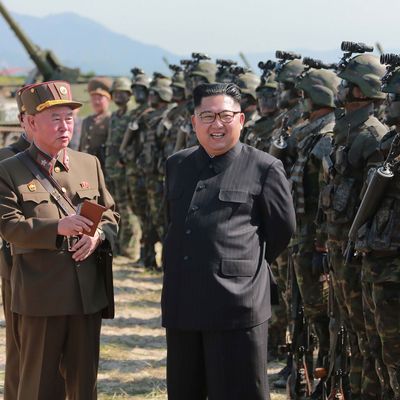
Another North Korean missile test, which the secretary of Defense asserted means Pyongyang could “hit anywhere in the world, basically.” A somber statement from the White House, with Secretary Mattis joining Trump and the GOP congressional leadership as the president asserted that he would “take care of it.” Meanwhile, on Twitter, a deluge of nuclear jargon and terrifying scenarios, with talk about miniaturized warheads, high trajectories, and a future of explosions in the Pacific — or on the East Coast. You’ve got questions. We’ve got answers.
Is this game-changing? No. Experts watching the march of North Korea’s nuclear program have said it was only a matter of time until Pyongyang demonstrated it could fire a rocket at a trajectory that would allow it to reach any part of the U.S. Recently, American officials have predicted North Korea would reach this milestone in 2018. This rocket flew farther and longer than any previous North Korean test — potentially around 8,000 miles, according to the calculations of physicist David Wright. That’s long enough to reach anywhere in the United States, including New York City, from North Korea. But Wright also points out the critical caveat: Its payload was a fake warhead, likely very light. An actual nuclear warhead would be much heavier, thus dramatically limiting how far it can go. Other scientists pointed out that the nighttime launch presented additional technical challenges — further demonstrating Pyongyang’s technical advances and potential to surprise us. That rocket might be able to deliver a payload of soap bubbles or fluffy bunnies to the streets of New York, but not a nuclear explosion. Yet.
So Trump was right when he said, “This changes nothing”? Yes. Mostly.
How did South Korea react? By immediately firing what Defense secretary Mattis called “pinprick” missiles and the South Korean military described as “a drill involving simultaneously hitting a target from the land, air and sea.” The exercise served as a reminder to the North that, if it were to set up a missile armed with a nuclear weapon, they could not assume they could get it off its launchpad in one piece … or, for that matter, that North Korea’s leadership could get out of such a confrontation alive. But that reality is not necessarily going to keep the situation on the Korean Peninsula relaxed.
What options does the U.S. have to respond? A conservative commentator and former government official called on the U.S. to “take out” the launchpad from which the missile came. That’s not going to happen, because students of North Korea believe it would spark a strong military response — and so does South Korea, which would oppose such a move. (Also such a strike would not be legal under international law, unless a missile with an operative warhead is sitting there ready to go.)
The usual other set of proposed options include: Press China to do more; complain that China isn’t doing more; try to find some aspect of North Korean connection to the outside world that is not already sanctioned and sanction it. These are harder than usual because China in fact has been doing a bit more, including closing “for repairs” a main bridge for commerce between the two countries. And tightening the screws any further on North Korea’s sources of outside money involves going through … Russia.
Washington can stage a show of force — and Mattis’s presence at the White House to discuss the test with Trump may suggest one is coming. But keep in mind that the South Koreans already beat us to the punch.
Does this mean the possibility for negotiations is dead? No. Following through on the little intimations of readiness to negotiate that have seeped out in recent days and weeks remains the really outside-the-box option — and there are signs that option is still alive. Earlier in November, China sent an envoy to Pyongyang, amid speculation that his message would be heavy on pressure to negotiate. On Tuesday morning, a South Korean official — in an unusual public discussion of the North’s nuclear program just hours before the missile launch — said his government would be willing to engage Pyongyang as a step toward launching negotiations, and even named an envoy. And U.S. diplomat Joseph Yun has continued to meet with North Korean counterparts throughout the missile tests and Twitter wars of the last year. History is full of regimes that were willing to come to the negotiating table after scoring a military success, but not before — or even ones that looked to manufacture a military success as a pretext to negotiate. Indeed, a Chinese diplomat who led the “Six-Party Talks” over North Korea’s nuclear program a decade ago had predicted that Kim would “do something more terrible and come to the negotiating table only after a big intercontinental ballistic missile test.”
What happens next? The situation doesn’t have to escalate. President Trump’s immediate comments after the test were restrained (“we will handle this”). South Korea is hosting the Winter Olympics in February, and would like “trajectory” and “time in flight” to refer to its ski jumpers and ice-hockey teams. But the pressure for more shows of strength from the U.S. and allied militaries will be high … and that ratchets up the possibility for misperception or overreaction. At the same time, to prove that its rockets actually can go the distance, one of North Korea’s next steps is likely to be firing one at a low trajectory 3,500 miles into the Pacific, flying over or near anxious islands on the way.
Trump will keep this problem totally separate from his domestic troubles, right? Ha, funny. President Trump predicted at his afternoon press availability that the test would help Congress pass a bigger military budget and help him corral Democrats.
At least as far as he is concerned, the missile was no dummy.





























